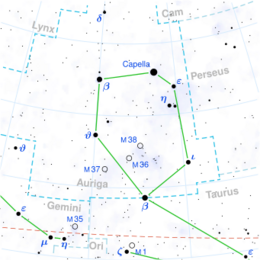Astronomy:Psi2 Aurigae
| Observation data Equinox J2000.0]] (ICRS) | |
|---|---|
| Constellation | Auriga |
| Right ascension | 06h 39m 19.82634s[1] |
| Declination | +42° 29′ 19.9617″[1] |
| Apparent magnitude (V) | 4.79[2] |
| Characteristics | |
| Spectral type | K3 III[3] or K3 Iab:[4] |
| U−B color index | +1.30[2] |
| B−V color index | +1.23[2] |
| R−I color index | 0.6 |
| Astrometry | |
| Radial velocity (Rv) | 16.09 ± 0.19[5] km/s |
| Proper motion (μ) | RA: -0.87[1] mas/yr Dec.: -54.97[1] mas/yr |
| Parallax (π) | 7.84 ± 0.29[1] mas |
| Distance | 420 ± 20 ly (128 ± 5 pc) |
| Absolute magnitude (MV) | −0.72[6] |
| Details | |
| Radius | 27[7] R☉ |
| Luminosity | 304[6] L☉ |
| Surface gravity (log g) | 2.30[8] cgs |
| Temperature | 4,410[8] K |
| Metallicity [Fe/H] | –0.10[8] dex |
| Rotational velocity (v sin i) | 1.0[9] km/s |
| Other designations | |
| Database references | |
| SIMBAD | data |
Psi2 Aurigae, Latinized from ψ2 Aurigae, is a star in the constellation Auriga. It is faintly visible to the naked eye with an apparent visual magnitude of 4.79.[2] Based upon parallax measurements, this star is approximately 420 light-years (130 parsecs) away from the Earth. At that distance, the brightness of the star is diminished by 0.07 in magnitude from extinction caused by interstellar gas and dust.[5]
Most studies categorized this as a K-type giant star with a stellar classification of K3 III.[3] However, the results of a study published in 2003 list it with a classification of K3 Iab:, which would instead suggest it is a supergiant star.[4][10] The measured angular diameter of this star, after correction for limb darkening, is 1.97 ± 0.02 mas.[11] At the estimated distance of this star,[1] this yields a physical size of about 27 times the radius of the Sun.[7] It is radiating 304[6] times the Sun's luminosity from its enlarged photosphere at an effective temperature of 4,410 K.[8]
It was also known to be part of a much bigger constellation named Telescopium Herschelii. It was also the constellation's second-brightest star before it was unrecognized by the International Astronomical Union (IAU).
See also
References
- ↑ 1.0 1.1 1.2 1.3 1.4 1.5 van Leeuwen, Floor (November 2007), "Validation of the new Hipparcos reduction", Astronomy and Astrophysics 474 (2): 653–664, doi:10.1051/0004-6361:20078357, Bibcode: 2007A&A...474..653V. Note: see VizieR catalogue I/311.
- ↑ 2.0 2.1 2.2 2.3 Johnson, H. L. et al. (1966), "UBVRIJKL photometry of the bright stars", Communications of the Lunar and Planetary Laboratory 4 (99): 99, Bibcode: 1966CoLPL...4...99J.
- ↑ 3.0 3.1 Herbig, George H.; Spalding, John F., Jr. (January 1955), "Axial Rotation and Line Broadening in Stars of Spectral Types F0-K5", Astrophysical Journal 121: 118, doi:10.1086/145969, Bibcode: 1955ApJ...121..118H.
- ↑ 4.0 4.1 Kidger, Mark R.; Martín-Luis, Fabiola (June 2003), "High-Precision Near-Infrared Photometry of a Large Sample of Bright Stars Visible from the Northern Hemisphere", The Astronomical Journal 125 (6): 3311–3333, doi:10.1086/374996, Bibcode: 2003AJ....125.3311K.
- ↑ 5.0 5.1 Famaey, B. et al. (January 2005), "Local kinematics of K and M giants from CORAVEL/Hipparcos/Tycho-2 data. Revisiting the concept of superclusters", Astronomy and Astrophysics 430 (1): 165–186, doi:10.1051/0004-6361:20041272, Bibcode: 2005A&A...430..165F.
- ↑ 6.0 6.1 6.2 Anderson, E.; Francis, Ch. (2012), "XHIP: An extended hipparcos compilation", Astronomy Letters 38 (5): 331, doi:10.1134/S1063773712050015, Bibcode: 2012AstL...38..331A.
- ↑ 7.0 7.1 Lang, Kenneth R. (2006), Astrophysical formulae, Astronomy and astrophysics library, 1 (3rd ed.), Birkhäuser, ISBN 3-540-29692-1, https://books.google.com/books?id=OvTjLcQ4MCQC&pg=PA41. The radius (R*) is given by:
- [math]\displaystyle{ \begin{align} 2\cdot R_* & = \frac{(128\cdot 1.97\cdot 10^{-3})\ \text{AU}}{0.0046491\ \text{AU}/R_{\bigodot}} \\ & \approx 54\cdot R_{\bigodot} \end{align} }[/math]
- ↑ 8.0 8.1 8.2 8.3 McWilliam, Andrew (December 1990), "High-resolution spectroscopic survey of 671 GK giants. I - Stellar atmosphere parameters and abundances", Astrophysical Journal Supplement Series 74: 1075–1128, doi:10.1086/191527, Bibcode: 1990ApJS...74.1075M.
- ↑ De Medeiros, J. R. et al. (November 2000), "Rotation and lithium in single giant stars", Astronomy and Astrophysics 363: 239–243, Bibcode: 2000A&A...363..239D.
- ↑ 10.0 10.1 "* 50 Aur". SIMBAD. Centre de données astronomiques de Strasbourg. http://simbad.u-strasbg.fr/simbad/sim-basic?Ident=%2A+50+Aur.
- ↑ Richichi, A.; Percheron, I.; Khristoforova, M. (February 2005), "CHARM2: An updated Catalog of High Angular Resolution Measurements", Astronomy and Astrophysics 431 (2): 773–777, doi:10.1051/0004-6361:20042039, Bibcode: 2005A&A...431..773R.
External links
 |


